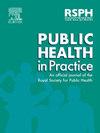Morbidity patterns of persons in prisons compared to the general Hungarian population between 2017 and 2019
IF 1.9
Q2 PUBLIC, ENVIRONMENTAL & OCCUPATIONAL HEALTH
引用次数: 0
Abstract
Objectives
Prison population around the globe tends be among the most marginalized population groups. Many of these persons struggle with numerous health problems, primarily with infectious diseases and mental disorders. Our goal was to analyse morbidity of prisoners compared to age- and gender-matched controls.
Study design
Case-control study based on administrative data of healthcare utilisation in Hungary between 2017 and 2019.
Methods
Patient numbers by ICD-10 chapters and tabulation lists of diagnosis (morbidity groups) were obtained from the government-funded single payer health insurance institute. Convicts were compared to controls matched by age and gender in a 5:1 ratio.
Results
The leading causes of healthcare utilisation of prisoners compared to controls by ICD-10 chapters were mental and behavioural disorders and external causes of morbidity, but the relative risk of healthcare use due to infectious diseases was not elevated. When investigating data at a more detailed level, that is, by morbidity groups, the relative risk of healthcare utilisation due to 19 out of a total of 299 morbidity groups was significantly, more than 3 times higher among prisoners compared to controls, and the first five highest relative risks were all due to external causes of injury.
Conclusion
The leading causes of morbidity among persons in prisons based on health care utilisation seems to be somewhat different from morbidity patterns identified by other methods such as clinical interviews, screening or estimations. Causes of health care utilisation both at ICD chapter and morbidity group-level is one of several relevant indicators of the health care needs of prison populations that uncovers the groups of most severe maladies among them. However, other sources of data should also be taken into account for the development of effective preventive and rehabilitative interventions. Follow-up of prisoner patients treated in health care would also be recommended to aid rehabilitation.
2017年至2019年,与匈牙利总人口相比,监狱服刑人员的发病率模式
世界各地的监狱人口往往是最边缘化的人口群体。其中许多人患有各种健康问题,主要是传染病和精神障碍。我们的目标是将囚犯的发病率与年龄和性别匹配的对照组进行比较。研究设计:基于2017年至2019年匈牙利医疗保健利用管理数据的病例对照研究。方法从政府资助的单一付款人医疗保险机构按ICD-10章节和诊断(发病组)表获取患者编号。罪犯与按年龄和性别匹配的对照组以5:1的比例进行比较。结果根据ICD-10章节,与对照组相比,囚犯利用医疗保健的主要原因是精神和行为障碍以及发病的外部原因,但由于传染病而使用医疗保健的相对风险并未升高。在对数据进行更详细的调查时,即按发病率组进行调查,在299个发病率组中,有19个囚犯利用医疗保健的相对风险明显高于对照组,是对照组的3倍以上,前五个最高的相对风险都是由于外部原因造成的伤害。结论:基于医疗保健利用的监狱在押人员发病的主要原因似乎与通过临床访谈、筛查或估计等其他方法确定的发病模式有所不同。《国际疾病分类》章节和发病率群体一级的保健利用原因是监狱人口保健需求的几个相关指标之一,它揭示了监狱人口中最严重疾病的群体。但是,在制定有效的预防和康复干预措施时,也应考虑到其他数据来源。还建议对在保健机构接受治疗的囚犯病人进行后续行动,以协助康复。
本文章由计算机程序翻译,如有差异,请以英文原文为准。
求助全文
约1分钟内获得全文
求助全文

 求助内容:
求助内容: 应助结果提醒方式:
应助结果提醒方式:


